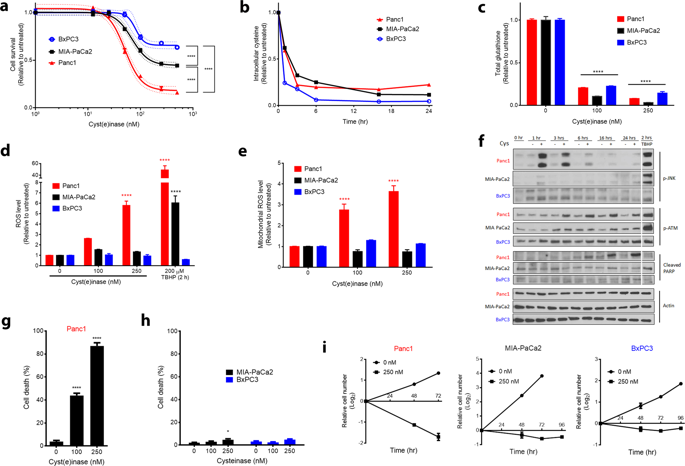npj Precision Oncology ( IF 6.8 ) Pub Date : 2019-06-03 , DOI: 10.1038/s41698-019-0088-z Sabin Kshattry 1 , Achinto Saha 1 , Paul Gries 2 , Stefano Tiziani 2 , Everett Stone 3 , George Georgiou 3, 4 , John DiGiovanni 1

|
Perturbing redox homeostasis potentially constitutes a selective cancer-killing strategy. An engineered human enzyme, cyst(e)inase that degrades extracellular cysteine (l-Cys) and cystine (CSSC) leading to depletion of intracellular l-Cys and glutathione (GSH) was evaluated for its effects on pancreatic cancer cell lines. Cyst(e)inase caused oxidative stress and apoptosis in only Panc1 cells, whereas MIA-PaCa2 and BxPC3 cells demonstrated survival under conditions of cyst(e)inase-mediated l-Cys depletion through maintenance of mitochondrial metabolism and lower levels of reactive oxygen species (ROS). A correlation was also observed between thioredoxin 1 protein levels and resistance to cyst(e)inase treatment. Notably, cyst(e)inase in combination with auranofin, a thioredoxin reductase inhibitor, caused a synergistic increase in mitochondrial ROS and apoptosis and inhibition of mitophagy in the more resistant cells. In addition, auranofin treatment sensitized the more resistant pancreatic cancer xenografts to cyst(e)inase without systemic toxicity. These data provide strong rationale to further investigate therapeutic strategies that target multiple antioxidant pathways for treatment of pancreatic ductal adenocarcinoma.
中文翻译:

酶介导的 L-半胱氨酸消耗与硫氧还蛋白还原酶抑制协同作用,抑制胰腺肿瘤生长
扰乱氧化还原稳态可能构成一种选择性的癌症杀死策略。一种工程化的人类酶,半胱氨酸酶,可降解细胞外半胱氨酸 ( l -Cys) 和胱氨酸 (CSSC),从而导致细胞内l -Cys 和谷胱甘肽 (GSH) 的消耗,评估了其对胰腺癌细胞系的影响。半胱氨酸酶仅在 Panc1 细胞中引起氧化应激和细胞凋亡,而 MIA-PaCa2 和 BxPC3 细胞通过维持线粒体代谢和较低水平的活性氧,在半胱氨酸酶介导的l -Cys 耗竭的条件下表现出生存能力(ROS)。硫氧还蛋白 1 蛋白水平与胱氨酸酶治疗耐药性之间也观察到了相关性。值得注意的是,胱氨酸酶与金诺芬(一种硫氧还蛋白还原酶抑制剂)联合使用,可协同增加线粒体 ROS 和细胞凋亡,并抑制耐药细胞中的线粒体自噬。此外,金诺芬治疗使胰腺癌异种移植物对胱氨酸酶更加敏感,且没有全身毒性。这些数据为进一步研究针对多种抗氧化途径治疗胰腺导管腺癌的治疗策略提供了强有力的依据。









































 京公网安备 11010802027423号
京公网安备 11010802027423号